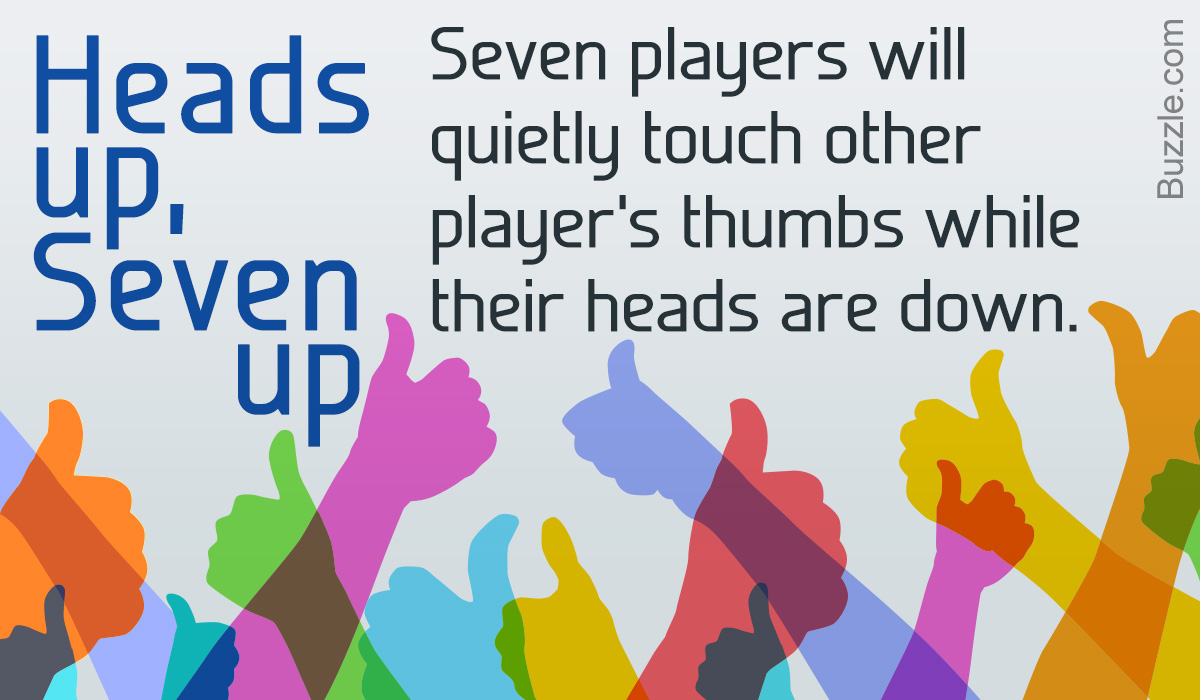How To Play Heads Up Seven Up
The Tools of Randomness
Updated on February 20, 2021. Philip Lee Harvey / The Image Bank / Getty Images. To play the 7-Up ball game, all you need is a smooth, flat surface (a wall or a floor) and a bouncy ball. If you have a safe, open indoor space (without breakables), you can even play 7-Up inside.
- The Return to Play Progression process is best conducted through a team approach and by a health professional who knows the athlete’s physical abilities and endurance. By gauging the athlete’s performance on each individual step, a health care professional will be able to determine how far to progress the athlete on a given day.
- In the traditional game of 'Heads Up, Seven Up,' seven students stand at the front of the room while all others close their eyes and place their heads down. The standing players roam the room, and each chooses one seated student by gently tapping his or her head.
As humans, we naturally strive for some kind of order. The examples are many - schedules, tidy rooms, neatly folded clothes, and the like. Almost everything we do follows certain rules and regulations; there are laws in place and rules to adhere to.

How To Play Heads Up Seven Up Game
Still, order comes with a flaw - it's predictable. Of course, it certainly helps us with our daily tasks, but the colors change when something surprising happens. In fact, we cannot deny that we like surprises and coincidences. Therefore, we can say that while we are faithful to order and structure, we also enjoy flirting with randomness.
Here's an example we can all relate to - the 'shuffle' option on most music apps. Despite our tendency to create custom playlists, we still like when our app 'surprises' us with a song. That is especially true if we haven't heard that song in a while, not to mention that so many board and card games also depend on randomness.
In this article, we are going to talk about different ways we use randomness, as well as the tools we that help us achieve it.
Random Number Generators
There's one random number generator we are all familiar with - the lottery drum. As we know, this device pulls out a number of lottery balls at random and creates the winning combination. It ensures equal odds of winning for everyone playing. That is one of many ways we let randomness control a game.
The roulette wheel is also a common random number generator. We can never say for certain which number the ball will land on. In fact, the unpredictable nature of roulette is what makes it so thrilling in the first place. Even online slot games are essentially random number generators. Even though we see symbols, there is always a number behind each one.
Dice Rolling
Surely, dice are the most common random number generator. They are essential to many games, from Ludo and Monopoly to craps and Yahtzee. In the former two examples, rolling a die determines the movement of the player. In the latter two, dice are more central to the game instead of just being a tool.
The die we all know and love is a cube that generates a random number between 1 and 6. Of course, there are also dice that are not cubes and have between four and eight faces. For instance, role-playing games like Dungeons and Dragons often make use of those.
Unfortunately, the history of the die is a bit of a blur. Some say that the oldest dice could have been made some 5000 years ago. What we do know is that backgammon was one of the first games to use dice.
How Do You Play Heads Up 7 Up
It's a common belief that dice produce truly random numbers. However, scientists have discovered that it is not entirely true. For example, if we throw a die with the number one on top, there is more chance of it producing that same number. Still, we don't need to worry about that, since the outcome largely depends on the environment.

Dice have come a long way since their invention. Now, instead of using physical dice, we can simply roll a virtual die at freeonlinedice.com. By simply clicking on the die, we can roll it and produce a number between 1 and 6 completely at random. With the help of this simple but convenient website, we can roll a die virtually anywhere.
Coin Flip
Christopher Nolan's movie The Dark Knight introduced the villain Two-Face, who lets a coin flip decide his actions. Indeed, tossing a coin has always been a simple way to make a quick decision, since the odds are 50:50.
Throughout history, flipping a coin has resolved disputes, declared winners and even played a role in politics. In ancient times, people understood the outcome of a coin flip as a sign of divine will.
Interestingly enough, a coin flip had also decided which of the two Wright brothers would be the first to fly a plane. Even though Wilbur had won the coin toss, his attempt at flying was a failure. Yet, his brother Orville was successful.
In football, a coin flip decides which team kicks off the ball. When a team wins the coin toss, they can decide if they want to kick the ball or receive it. Moreover, the winning team can also choose which side of the field they want to defend.
The coin flip transcends to esports, as well. For example, Hearthstone uses it to decide which player goes first. Whoever loses the toss, gets a 'coin card', which also has its benefits.
Are the Odds Really Equal?
Earlier, we mentioned that the odds of a coin flip are 50:50. However, research shows that there is actually a bit of a bias that makes the toss less fair. More accurately, there is a 0.51 probability of catching the coin the same way we throw it.
Although both sides are made from raised metal, they show different images. Therefore, we can assume that one side is slightly heavier than the other.
Despite that, the coin flip is still a popular way to decide between two options. Nowadays, we don't even have to worry about the physics of it. Instead, we can go to freeonlinedice.com and do a virtual coin flip with a single click. It's a great way to quickly make up our mind anytime, anywhere. Honestly, flipping a real coin does leave some room for cheating. However, a virtual coin will always produce a random result.
The Bottom Line
It's interesting how often we let such small objects determine the course of our actions. Yet, it's fun, and sometimes necessary to give in to randomness. After all, not having the control of the outcome paves the way for interesting situations.
Rolling dice and tossing a coin have always been the simplest, yet most popular tools of randomness. Now that we can use them online, we are confident that they will stay relevant for years to come. The question remains - how lucky are we?
What it is: A grade school game played in a classroom, a quiet game to keep a class occupied.

Best for: A class at school.
What you need:
- The game works best when players have desks or tables to sit at. Other than that, you don’t need anything!
How to play: (Okay, this is reaching way back into my grade school memories for this one…) Heads up, seven up is a game often played in classrooms as a reward or to fill extra down time. It’s quiet and calm (great for teachers!) but fun for the kids.
To start, choose seven children. We’ll call them the Seven. They move to the front of the room and stand, facing the class. The rest of the class sit in their desks. Then the teacher (or whoever’s in charge) calls out, “Heads down, thumbs up!”
All the students sitting in their desks put their heads down and put one thumb in the air, like this:
They close their eyes and cover their faces so they can’t see. I seem to always remember the lights being off at this point, too, but maybe that’s unnecessary. Just tell kids not to peek.
How To Play Heads Up Virtually
Once all the students in their desks have their heads down and their thumbs up, the teacher signals to the Seven, who then quietly walk among the class. Each of the Seven picks one student sitting down and quietly touches their outstretched thumb. The student then tucks their thumb into their fist but continues waiting silently with eyes closed.
Once the Seven have all touched a thumb, they stand back at the front of the classroom. The teacher announces, “Heads up, seven up!” and all of the students in the class can raise their heads and open their eyes. The seven students whose thumbs were touched stand up.
Then the standing students each get one chance to guess which of the Seven touched their thumb. So, for example, let’s say Michael and Alyssa are two of the standing students whose thumbs were touched. Shelby and Drew are two of the Seven standing at the front of the classroom. On Michael’s turn, he gets to guess who touched his thumb. He might say, “Shelby?” But let’s say he’s wrong and it was another of the Seven who touched his thumb. Shelby says “no” and Michael sits down.
Then it’s Alyssa’s turn to guess. She says, “Drew?” And Drew is the one who touched Alyssa’s thumb. He would say “yes” and then he and Alyssa would switch spots. Drew goes back to his seat and becomes one of the sitting students and Alyssa gets to join the lucky Seven.
Once all of the standing students have had a chance to guess, everyone but the Seven sits down and the teacher calls “Heads down, thumbs up!” again. Play continues as long as you want!

To make it fair, the teacher can choose the order the standing students take when it’s their turn to guess. It’s best if the teacher varies it, sometimes going front of the class to back, sometimes right to left, sometimes left to right, etc., because the students who guess last are at an advantage.
Variations: You can easily play the heads up, seven up game with less than Seven if you have a smaller group.